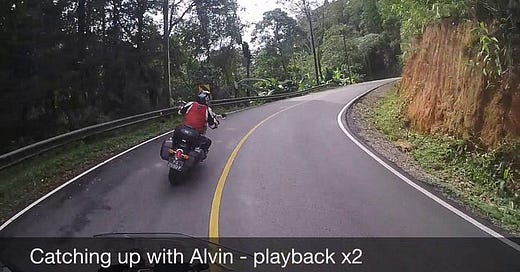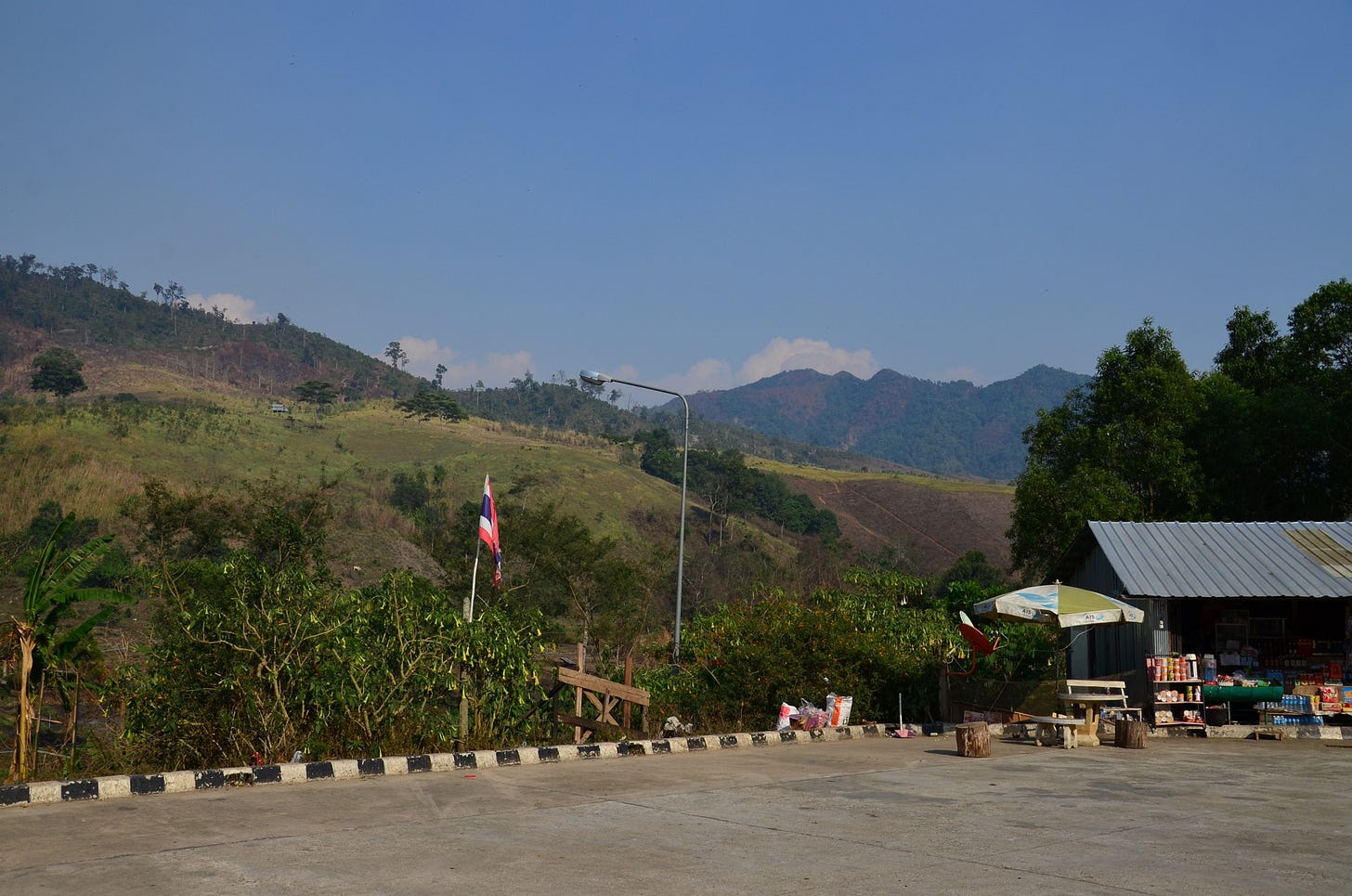Route 1090 runs south from Mae Sot to the isolated, mostly Karen, town of Umphang. The name “Death Highway” dates back to the 1980s. At that time, opium cultivation—and the security issues that come with it—was common. Opium is still grown in Tak province, but thanks to crop substitution work, has been reduced by some 80%. The days of seeing mountain ridges shimmering with poppy fields are gone.
The road though, has retained its name—at least in travel writing circles. With 1,219 curves, no traffic and ace scenery, this is one of Thailand’s top rides.
This Youtube video, from around the 5 minute mark, catches the beauty of the ride.
For all but the most determined, Route 1090 is a dead end—there is no road to Sangkhlaburi. You can trek there, though. The walk takes six to seven days, weaving you backwards and forwards over the Thai–Burma border.
I’ve been to Umphang a few times over the years, though the most memorable was quite a few years ago. Here we go with a tale from back then.
My girlfriend Nikki and I had arranged months earlier to meet a friend, Mark, in Umphang. We’ve been riding down the border from Mae Hong Son for weeks on an over-extended Mae Hong Son loop. By the time we roll into Mae Sot what is another 165 kilometres?
Bye bye Mae Sot. Photo: David Luekens.
Leaving the wooden No 4 Guesthouse, we hit the market. After a breakfast of coffee, jok and cheap cigarettes, we get going. The first 45 kilometres takes us through farmland, mountains in the distance, bright warm sunlight on the skin. Bliss. Just after Ban Rom Klao, we pass an unmanned police checkpoint and start climbing.
The air cools, the road shoulders dampen, and the traffic drops from light to non-existent. Forest closes in and we start working our way through the road’s 1,219 curves.
Valley scenes before the hills begin. Photo: Stuart McDonald.
Nikki and I have been working on quitting smoking for weeks. With the fresh morning air blasting in my face, now seems as good a time as any to quit. So while Nikki enjoys the scenery, I pull our last pack of cigarettes out of my pocket. Then, unbeknownst to her, drop them to the road along a lengthy fast straight.
Littering I know, and, well, karma would come fast and furious.
Taking a rest stop with a view of what is coming. Photo: David Luekens.
Another 15 kilometres brings us to a series of switchbacks. We haven’t seen a vehicle in 30 minutes, then, while pulling out of a hairpin, the bike feels real soft.
The back tire is all over the place and I sense Nikki wriggling, trying to see what the problem is, and then I hear it.
Thud thud thud thuuuuuud.
We have a flat. Oh crap.
I pull up. The rim is hot to touch, the tire, like me, deflated.
Double crap.
I wheel the bike onto the shoulder. Spinning the wheel I see a bent nail.
Bastard!
Of course we have no puncture kit—and as Nikki is about to discover, no cigarettes.
Padding her pockets, she asks for them.
“I threw them away.”
“What?”
“I threw them away. After the checkpoint. I thought we were going to give up.”
“Are you f%$^ joking. This is not funny.”
“No. Sorry.”
“You are an idiot. Do not speak to me.”
I won’t go any further into the blow by blow as I’m sure you get the idea. Believe me, the one way to make having a flat tire in a remote area worse is by throwing away your only cigarettes 15 kilometres ago without telling your girlfriend.
If you’re not riding yourself, songtheaws are the way to go. Photo: David Luekens.
Nicotine issues aside, we are in a bind. We know there’s a town about 15 kilometres back, but it will be a very hilly push. We decide to wait for a ride so one of us can go find a mechanic.
For two hours we sit by the side of the road. What a glorious and loving two hours it is.
Then, a pick-up slows to a stop. They toss the bike and us into the back and drive into town. No way will they take our money.
Tire fixed, and yes, cigarettes purchased—two packs in fact.
“If you want to throw away cigarettes, throw your own away. Idiot.”
Happy days.
The ride improves our mood... well after 100 kilometres or so.
We pass through thick forest, but I don’t have time to look up as I’m concentrating on the road. Nikki later remarks it is one of the most beautiful rides we’ve done—and we’ve done a lot of miles at this point.
This video has some great drone shots capturing what the road is like.
The forest opens up now and then, revealing vast cabbage and corn plantations. In Umphang we’re told cabbage is crop substitution at work, but it needs vast deforestation to set up. As the guesthouse owner surmises:
“You need to sell a lot of cabbage to earn the same as opium.”
About 40 kilometres shy of Umphang we pull up at a viewpoint. It feels like we’re gazing right across Burma—ridge after ridge after ridge. Though the early afternoon light washes it out somewhat, the layering is magnificent.
The last segment is a beautiful valley run. Agriculture surrounds us, distant mountain ranges to the left and right. We’ve seen perhaps 20 cars through the entire ride. The heat is easing and if we were running any later, a jacket would be welcome.
Umphang is a village more than a town and we don’t need a map to find the guesthouse. It is almost last light when we pull up out front, the friendly owner greets us and we say we’re here to see our friend Mark.
“Who? There’s nobody here.”
Tomorrow, more on our search for Mark and the gobsmacking beauty of Umphang’s surrounds. See you then.

















Share this post